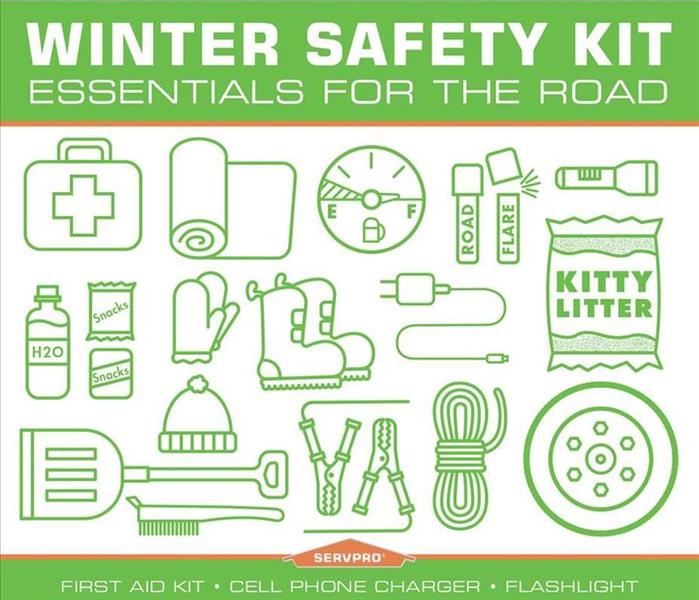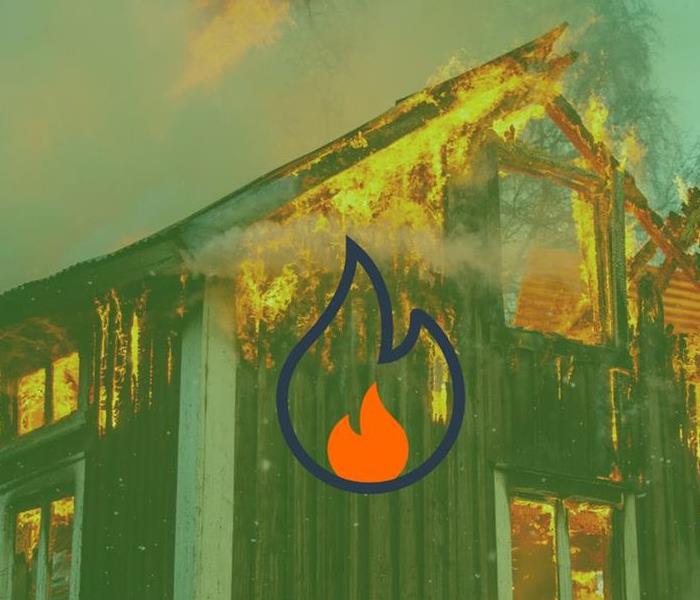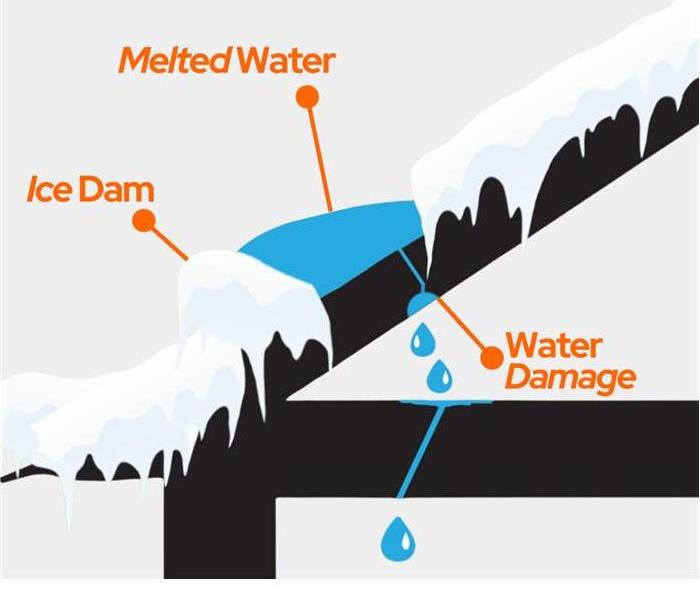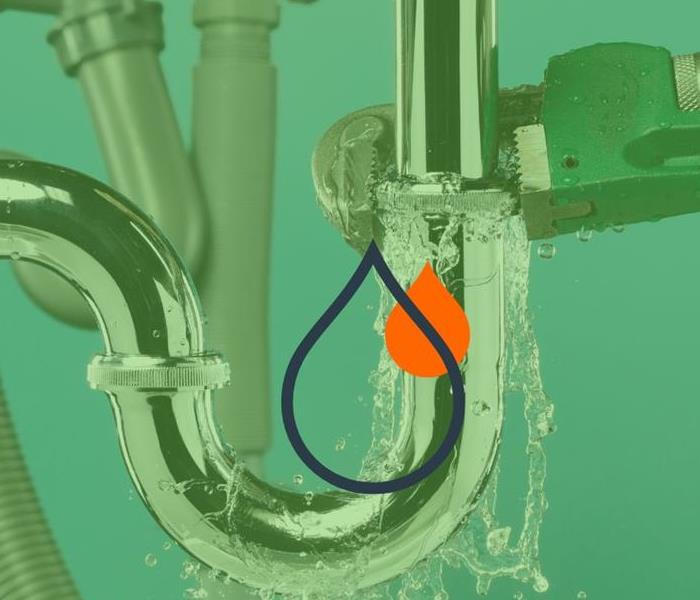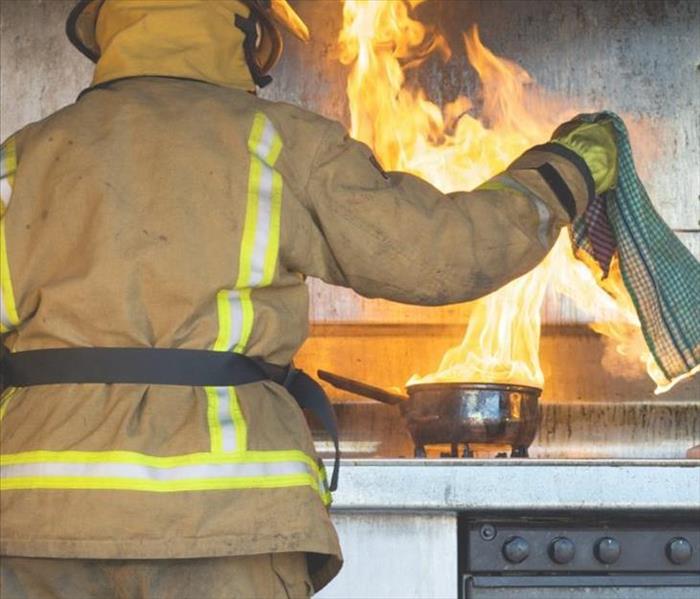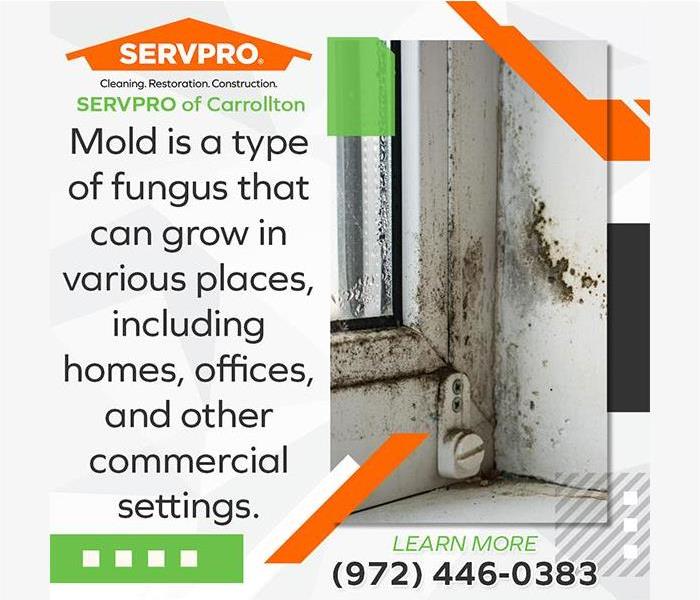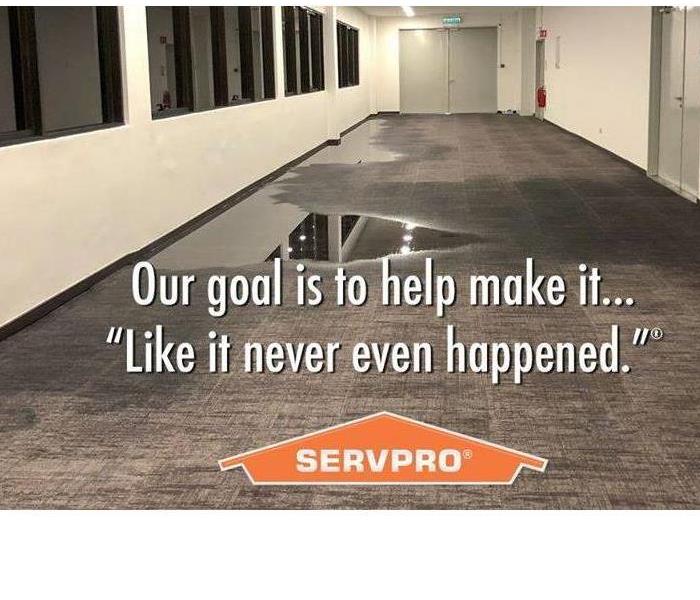Fire damage restoration steps: A guide for homeowners
7/25/2024 (Permalink)
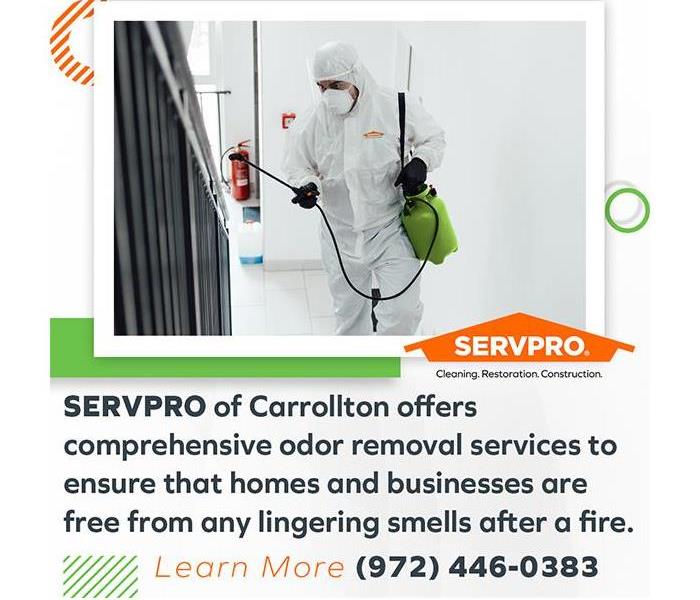 SERVPRO professional in protective gear using a spray hose for odor removal after a fire, ensuring homes and businesses are free from lingering smell.
SERVPRO professional in protective gear using a spray hose for odor removal after a fire, ensuring homes and businesses are free from lingering smell.
Key takeaways
- Understanding the essential steps in fire damage restoration can help homeowners manage the recovery process more effectively.
- Professional fire damage restoration includes extensive smoke removal and thorough cleaning to ensure safety and habitability.
- SERVPRO of Carrollton offers expert smoke removal services in Carrollton to address all aspects of fire damage.
Fire damage can be devastating for any homeowner. At SERVPRO of Carrollton, we understand the emotional and physical toll such events can take. This guide aims to provide a comprehensive overview of the fire damage restoration process, ensuring you know what to expect and how to handle each step. With our expert smoke removal services, we aim to help alleviate the damage caused by fire and smoke in Carrollton.
Initial assessment and safety
A critical first step in the fire damage restoration process involves conducting an initial assessment and ensuring safety. This includes verifying the structural integrity of the property, identifying potential hazards, and creating a detailed plan for effective restoration. SERVPRO of Carrollton prioritizes understanding the full extent of the damage and verifying the structural integrity of the property. This helps create a comprehensive plan for effective and safe restoration.
Assessing the extent of damage
The first step in fire damage restoration is conducting a thorough assessment of the affected area. This involves evaluating structural damage, soot and smoke penetration, and other factors to develop an effective restoration plan.
- Visual inspection: The team conducts a detailed visual inspection to identify visible signs of damage to the structure and contents.
- Structural integrity check: They assess the stability of walls, ceilings, and floors to determine if any immediate repairs are needed.
- Soot penetration analysis: Examining the extent of soot coverage on surfaces, including walls, ceilings, and personal belongings.
- Smoke damage assessment: Identifying areas affected by smoke to determine the depth of smoke penetration and odor concentration.
- HVAC system inspection: Checking the HVAC system for smoke and soot infiltration, which can spread contaminants throughout the property.
- Moisture detection: Evaluating moisture levels from firefighting efforts to prevent mold growth and further damage.
- Content inventory: Documenting and assessing damage to personal belongings and furnishings to determine salvageable items.
Ensuring structural safety
- Wall stability: Inspecting walls for signs of weakness or damage that could pose a risk during restoration.
- Ceiling integrity: Checking ceilings for structural soundness and potential hazards like sagging or collapse.
- Floor safety: Assessing floors for damage that could make them unsafe to walk on, including warping or buckling.
- Electrical system inspection: Ensuring the electrical system is safe to prevent any risk of fires or electrical hazards during restoration.
- Hazardous materials identification: Identifying any hazardous materials, such as asbestos or lead, that may require special handling.
- Temporary support installation: Installing temporary supports if needed to stabilize weakened structures during the restoration process.
- Safety barriers: Setting up safety barriers and signage to protect occupants and workers from potential hazards.
Immediate actions post-fire
After a fire, taking immediate action is crucial to prevent further damage and start the restoration process. This includes securing the property, addressing water damage, and initiating initial cleanup measures. SERVPRO of Carrollton understands the urgency and importance of these initial steps. By quickly securing the property and addressing water damage, the foundation for a successful fire damage restoration is established.
Securing the property
- Boarding up windows and doors: This involves installing boards over broken windows and doors to prevent unauthorized entry and protect the interior from weather elements. Ensuring these barriers are securely fastened is essential for maintaining the safety of the property.
- Temporary fencing: Setting up temporary fencing around the property to keep out trespassers and ensure safety.
- Roof tarping: Placing tarps over damaged sections of the roof to prevent water intrusion and additional damage.
- Locking down vulnerable areas: Securing any access points that could be exploited, including garages and sheds.
- Removing debris: Clearing the area of hazardous debris to create a safer environment for the restoration team.
- Installing security cameras: Setting up temporary security cameras to monitor the property and deter potential intruders.
- Posting warning signs: Place signs around the property to warn of potential hazards and indicate restricted access areas.
Water removal and drying
- Extracting standing water: Using industrial-grade pumps and vacuums to remove standing water left by firefighting efforts.
- Dehumidification: Deploying commercial dehumidifiers to reduce moisture levels and prevent mold growth.
- Air movement: Setting up high-speed air movers to enhance airflow and speed up the drying process.
- Moisture monitoring: Using moisture meters and sensors to track drying progress and ensure all areas are thoroughly dried.
- Drying of personal belongings: Carefully drying affected personal items and furnishings to salvage as much as possible.
- Carpet and upholstery drying: Specialized drying techniques for carpets and upholstery to prevent damage and mold growth.
- Document drying: This involves employing specialized freeze-drying techniques to salvage important documents and records that have been damaged by water. Proper handling is critical to preserving their condition.
Smoke and soot removal
Smoke and soot can cause extensive damage and lingering odors long after a fire has been extinguished. Effective smoke and soot removal are essential for restoring the property to a safe and habitable condition. This process includes various techniques to eliminate harmful residues and odors, ensuring a thorough cleanup. SERVPRO of Carrollton offers comprehensive smoke removal in Carrollton, TX, using advanced techniques to ensure the complete elimination of harmful residues and odors.
The importance of smoke removal
- Odor elimination: Lingering smoke odors can make a property uninhabitable, necessitating thorough removal.
- Structural integrity: Smoke can weaken the structure of a building by affecting its materials and surfaces.
- Content protection: Personal belongings, furniture, and appliances can be damaged by smoke residues, requiring professional cleaning.
- Air quality improvement: Removing smoke particles from the air enhances indoor air quality, making it safer for occupants.
- Preventing further damage: Immediate smoke removal prevents further corrosion and staining of surfaces.
- Comprehensive restoration: Professional smoke removal is crucial for ensuring a complete and thorough restoration process.
Techniques for soot and odor removal
- Thermal fogging: This technique neutralizes odors by using heated deodorizing solutions that penetrate affected areas.
- Ozone treatments: Ozone generators break down odor-causing molecules, effectively eliminating persistent smells.
- HEPA filtration: High-efficiency particulate Air (HEPA) filters capture microscopic soot particles, improving air quality.
- Hydroxyl generators: Safe for use in occupied spaces, these generators help remove odors and improve air quality.
- Encapsulation: Sealing affected areas and materials to prevent odors from resurfacing.
- Chemical cleaners: Specialized cleaning agents designed to remove soot and neutralize odors on various surfaces.
- Air scrubbers: These devices remove particles, gases, and chemicals from the air, further improving air quality.
Cleaning and sanitizing
After a fire, cleaning and sanitizing are crucial steps to restore the property and ensure it is safe for occupancy. SERVPRO of Carrollton provides comprehensive cleaning and sanitizing services, focusing on removing soot and odors, as well as disinfecting all affected areas. This process not only restores the property's appearance but also enhances its safety and livability.
Cleaning fire-damaged items
Items affected by fire damage need special attention. The team at SERVPRO of Carrollton carefully cleans and sanitizes personal belongings, furniture, and other items to restore them to their pre-fire condition.
- Delicate handling: Personal items are handled with care to prevent further damage during the cleaning process.
- Specialized cleaning techniques: Using specific methods tailored to different materials, such as dry cleaning for fabrics and ultrasonic cleaning for intricate items.
- Deodorization: Removing lingering smoke odors from personal belongings to restore them to a usable state.
- Electronics cleaning: This involves specialized techniques to clean electronic devices, remove soot, and prevent damage caused by smoke residues. Proper care is taken to ensure electronics are restored to working condition.
- Document restoration: Using freeze-drying techniques to salvage important documents and records.
- Furniture restoration: Thorough cleaning and deodorizing of furniture to remove soot and smoke residues.
- Inventory and assessment: Documenting and assessing the condition of each item to determine the best cleaning method.
Sanitizing affected areas
- Surface disinfection: Applying industrial-grade disinfectants to all surfaces to eliminate bacteria and contaminants.
- Air quality improvement: Using air scrubbers and filtration systems to remove airborne particles and improve indoor air quality.
- Carpet and upholstery sanitizing: Deep cleaning of carpets and upholstery to remove soot, odors, and contaminants.
- HVAC system cleaning: Cleaning and sanitizing the HVAC system to prevent the spread of soot and smoke particles.
- Hard surface cleaning: Thoroughly cleaning and disinfecting hard surfaces, such as floors, countertops, and walls.
- Mold prevention: Applying antimicrobial treatments to prevent mold growth due to moisture from firefighting efforts.
- Final inspection: Conducting a final inspection to ensure all areas are thoroughly sanitized and safe for reoccupation
Restoration and repairs
Restoration and repairs are the final and crucial steps in the fire damage recovery process. At SERVPRO of Carrollton, we ensure that every aspect of your property is restored to its pre-fire condition. This involves addressing structural repairs, aesthetic improvements, and thorough final inspections to guarantee quality and safety.
Structural repairs
Restoring the structural integrity of your property is a crucial step in the restoration process. This includes addressing issues such as damaged drywall, flooring, and roofing to ensure the property is safe and secure.
- Drywall replacement: Removing and replacing damaged drywall to restore walls to their original condition.
- Painting: Repainting walls and ceilings to eliminate any traces of soot and smoke damage, giving your property a fresh, clean look.
- Flooring repair and replacement: Assessing and repairing damaged flooring, or replacing it if necessary, to ensure a safe and aesthetically pleasing environment.
- Roof repair: Addressing any fire or water damage to the roof, ensuring it is secure and weatherproof.
- Window and door replacement: Replace any windows and doors that were damaged by the fire to restore security and insulation.
- Structural reinforcement: Strengthening weakened structural components to ensure the building's stability and safety.
- Masonry work: Repairing or replacing damaged bricks, stonework, or other masonry elements to restore the exterior of the property.
Final inspections
Before completing the restoration process, our team conducts a final inspection to ensure that all work meets our high standards of quality and that the property is fully restored to your satisfaction.
- Comprehensive evaluation: Performing a thorough check of all repaired and restored areas to ensure quality artistry.
- Safety inspection: Ensuring that all repairs meet safety standards and that the property is safe for reoccupation.
- Client walkthrough: Walking through the property with the client to review the completed work and address any concerns.
- Documentation: Providing detailed documentation of all repairs and restorations for insurance and record-keeping purposes.
- Functionality testing: Testing systems such as plumbing, electrical, and HVAC to confirm they are functioning correctly after repairs.
- Cleanliness check: Ensuring that the property is clean and free of construction debris, ready for the client's return.
- Final approval: Obtaining the client's final approval to confirm their satisfaction with the restoration services provided.
Why choose SERVPRO of Carrollton?
- Experienced professionals: Our team consists of smoke removal experts with extensive experience in handling fire damage restoration, ensuring high-quality results.
- Comprehensive services: As experts in smoke and odor removal, we offer a full range of services, from initial assessment to complete restoration, addressing all aspects of fire damage.
- Advanced technology: Utilizing the latest technology and equipment, we provide effective and efficient smoke removal and restoration services, guaranteeing thorough cleanup and odor elimination.
- Certified technicians: Our technicians are certified and continuously trained in the latest techniques and industry standards, making us the leading experts in smoke and odor removal.
- Rapid response: We are known for our prompt response to emergencies, minimizing damage, and beginning the restoration process as quickly as possible.
- Customer satisfaction: Committed to excellence, we prioritize customer satisfaction, working closely with clients to meet their specific needs and ensure they are fully satisfied with the restoration process.
- Local expertise: With extensive experience in smoke removal services throughout Texas, we are well-versed in the unique challenges faced by Carrollton residents. We provide tailored solutions to address these specific needs effectively.
Choose Smoke Removal Experts For Fire Damage Restoration In Carrollton, TX
Dealing with fire damage can be overwhelming, but knowing the restoration steps can help you navigate the process more effectively. SERVPRO of Carrollton is here to provide expert assistance with smoke removal services in Carrollton, TX, and extensive fire damage restoration. Contact us today at (972) 446-0383 to learn more about our smoke removal services and how we can help restore your home.
The complete manual for mold removal for restoration companies
5/16/2024 (Permalink)
We will explore the fundamentals of mold remediation services in this extensive book, offering priceless insights into the threat of mold infestation and its possible dangers. Mold growth is a common problem in many residential and commercial settings, thriving in damp and poorly ventilated areas. To effectively tackle its presence, it is crucial to comprehend the root causes and conditions favorable for mold growth. The purpose of this is to provide you with important knowledge about mold infestation and the hazards associated with it.
From dampness to disaster: The structural and financial impact of mold on properties
Mold infestation poses a significant threat to the value of residential and commercial properties due to its potential consequences for structural integrity and aesthetics. Property owners frequently encounter the proliferation of mold, particularly in areas prone to dampness and poor ventilation. The presence of mold often indicates underlying issues such as water intrusion, leaks, or excessive humidity, all of which can contribute to its growth.
Structural Damage
The ramifications of mold infestation are multifaceted, with two primary areas of concern: structural damage and aesthetic deterioration. Firstly, mold can compromise the structural integrity of a building by weakening materials such as drywall, wood, and insulation. Mold growth on these surfaces can lead to decay and rot, compromising strength and stability. In severe cases, prolonged mold exposure can result in structural failures, necessitating extensive repairs or demolition. Such structural issues can profoundly impact the property's value, as the prospect of costly repairs or safety concerns may deter potential buyers or tenants.
Aesthetic Deterioration
Mold infestation can also adversely affect the property's aesthetics. Mold growth is often accompanied by unsightly stains, discoloration, and odors, which can detract from the property's visual appeal. Whether visible on walls, ceilings, or other surfaces, mold can create a negative impression and diminish the overall attractiveness of the property. In real estate transactions, the appearance of mold can be a significant deterrent to potential buyers or lessees, leading to decreased demand and lowered property values.
Perception of Poor Maintenance
Moreover, mold can signal broader issues with the property's maintenance and upkeep. A mold-infested building may be perceived as poorly maintained or neglected, raising concerns about the reliability of its infrastructure and systems. Prospective buyers or tenants may view mold as a red flag, prompting them to question the property's overall condition and reliability. As a result, properties with a history of mold infestation may need help attracting buyers or lessees, leading to prolonged vacancies and reduced rental or sale prices.
Financial Implications
In addition to the direct impact on property value, mold infestation can result in significant financial losses for property owners. The cost of remediation and repairs can quickly escalate, particularly if mold has spread extensively throughout the building. Mold remediation requires specialized expertise, equipment, and materials, which can contribute to substantial expenses. Furthermore, the longer mold infestation is left unaddressed, the greater the risk of further damage and associated costs. Property owners may also incur losses in terms of lost rental income or decreased property values, further exacerbating the financial implications of mold infestation.
Proactive measures for prevention
Therefore, property owners must take proactive measures to identify and rectify underlying issues contributing to mold growth. This may involve conducting regular inspections, promptly addressing water leaks or drainage issues, improving ventilation systems, and implementing moisture control measures. By addressing these underlying issues, property owners can mitigate the risk of mold infestation and preserve the value of their investments. Additionally, investing in professional mold remediation services can help ensure thorough and effective mold removal, minimizing its impact on property value and safeguarding against future infestations.
Hence, it is crucial to understand that mold is not just an unsightly nuisance but a potential threat to the structural integrity of a building. Mold growth can compromise building materials, such as drywall and wood, leading to deterioration and weakening of the structure over time. Additionally, mold infestation can result in unpleasant odors and cosmetic damage, diminishing the property's appeal and marketability. This emphasizes the importance of addressing mold infestations promptly and effectively to maintain the value of the building.
Importance of prompt mold remediation
Mold infestations must be remedied promptly and thoroughly to prevent additional property damage and protect the health of people who live or work in the affected area. The longer the mold is left untreated, the more severe the damage can become. We've seen cases where mold has caused structural damage to properties, leading to repairs that cost an arm and a leg.
Moreover, suppose occupants are exposed to mold spores for extended periods. In that case, it can aggravate existing health conditions and lead to serious health risks. Therefore, it is essential to take immediate action to mitigate the negative impact of mold infestations through effective mold remediation measures.
Professional intervention is crucial in ensuring thorough and effective mold removal. Trained technicians, equipped with specialized equipment and expertise, can accurately assess the extent of mold infestation, implement appropriate containment measures, and safely remove mold from affected areas. We want to give property owners the tools they need to safeguard their residences and places of business against the damaging effects of mold infestation by emphasizing the significance.
The mold remediation process
In our guide to mold removal services, we explain the intricacies of the mold remediation process, starting with the crucial initial assessment and inspection step.
Initial assessment and inspection
The initial assessment and inspection phase is pivotal in determining the extent of mold infestation and devising an effective remediation plan. Skilled experts comprehensively assess the property, paying close attention to regions vulnerable to mold growth, such as crawl spaces, basements, attics, and bathrooms.
Specialized equipment, such as moisture meters and thermal imaging cameras, may be used during this phase to identify hidden moisture sources and mold-contaminated regions. Visual inspection and air quality testing are also conducted to assess the severity of mold growth and the presence of airborne mold spores.
By conducting a comprehensive assessment and inspection, mold remediation experts can accurately gauge the scope of the problem and formulate a tailored remediation strategy to address the property's specific needs. By taking preventative measures, mold can be removed effectively and specifically, causing the least disturbance to residents and making restoring a safe and healthy indoor environment easier.
Containment strategies and mold isolation
Efficient containment strategies are critical for mold spores to stay contained during remediation. This is why professionals utilize containment measures, such as sealing the affected areas with plastic sheeting and creating negative air pressure environments through specialized equipment like air scrubbers. These measures safeguard the health and safety of the workers and residents involved by isolating the mold-infested areas and reducing the chance of cross-contamination. Using reliable containment measures is a crucial component of successful mold remediation.
Safe and effective mold removal techniques
Safe and effective mold removal techniques are paramount in eliminating mold growth while minimizing health risks and property damage. Trained technicians employ industry-approved methods, such as HEPA vacuuming, damp wiping, and abrasive cleaning, to remove mold from surfaces. Non-toxic cleaning agents and antimicrobial solutions may also disinfect and inhibit mold regrowth.
Also, proper personal protective equipment (PPE) is worn during mold removal to protect workers from exposure to mold spores and hazardous materials. By adhering to stringent safety protocols and utilizing proven removal techniques, professionals ensure thorough and safe mold eradication, restoring indoor air quality and preserving the integrity of the property.
Drying, dehumidification, and moisture control
Drying, dehumidification, and moisture control prevent mold recurrence and promote a healthy indoor environment. After mold removal, technicians employ industrial-grade air movers, dehumidifiers, and moisture meters to dry affected surfaces and restore optimal humidity levels thoroughly.
By eliminating excess moisture and addressing underlying water issues, such as leaks or condensation, professionals mitigate the risk of mold regrowth and secondary damage to the property. Meticulous drying and moisture control measures ensure long-term protection against mold infestation.
Once the mold is removed, you can have peace of mind knowing that your property is less likely to experience mold issues. In addition to enhancing the health and welfare of the occupants, this maintains the structural integrity of the building and may spare you from future expensive repairs.
Advantages of professional mold removal services
Discover the advantages of opting for professional mold removal services and why entrusting the task to trained experts is essential for effective remediation.
Expertise and specialized knowledge
One of the primary advantages of professional mold removal services lies in the expertise and specialized knowledge of trained technicians. These experts undergo demanding training and certification courses like NEHA and ACAC to thoroughly understand mold behavior, identification methods, and remediation tactics. This guarantees they have the ability and information to deal with mold infestation situations safely and effectively.
One advantage of hiring a professional mold removal company is that the skilled technicians have specific training and knowledge in the field. These professionals undergo demanding training and certification programs to thoroughly understand mold behavior, identification methods, and rem radiation strategies.
Experts in mold remediation possess vast knowledge and expertise, enabling them to evaluate the degree of mold infestation precisely, recognize underlying moisture problems, and create customized remediation strategies to meet individual requirements. They are well-versed in industry best practices and adhere to stringent safety protocols to ensure thorough and effective mold removal, providing property owners with the confidence that their mold issues are handled professionally.
Moreover, professionals can access state-of-the-art equipment, specialized tools, and advanced technologies to tackle mold contamination with precision and efficiency. They use state-of-the-art methods to minimize disturbance to the property and its occupants while achieving the best results, ranging from safe removal techniques to containment strategies.
By engaging the services of qualified professionals, property owners can benefit from the assurance of thorough mold removal, enhanced indoor air quality, and long-term protection against mold recurrence. With their expertise and specialized knowledge, mold remediation experts provide invaluable support in restoring a safe and healthy living environment for occupants.
Comprehensive solutions tailored to your needs
Professional mold removal services offer comprehensive solutions tailored to your specific needs. Trained technicians conduct thorough assessments to identify the extent of mold contamination and assess any underlying moisture issues. Their customized remediation plans consider your property's needs and are developed based on their findings.
When managing a minor localized mold infestation or large-scale contamination, professionals possess the knowledge and assets to execute efficient remediation techniques. From containment and isolation techniques to safe removal methods and moisture control measures, they ensure a comprehensive approach to mold removal that delivers lasting results.
By tailoring their solutions to your needs, mold remediation experts ensure that every aspect of the process is carefully planned and executed to achieve optimal outcomes. Professional services provide peace of mind that your property will be restored to a safe and healthy condition, whether you are dealing with a residential or commercial mold problem.
Assurance of health and safety compliance
When you enlist the services of professional mold removal experts, you can rest assured that they will follow stringent health and safety compliance standards throughout the entire remediation process. These highly trained technicians deeply understand the intricate industry regulations and mold remediation guidelines. They ensure that all safety procedures are strictly followed because they are familiar with the specific guidelines set by reputable agencies like the Environmental Protection Agency and the Occupational Safety and Health Administration (OSHA).
Professionals place a high priority on the safety of both workers and occupants, from putting containment measures in place to wearing the proper personal protective equipment (PPE) to making sure there is enough ventilation. They reduce the possibility of contact with mold spores and dangerous materials by adhering to established protocols and safety procedures, protecting everyone's health and well-being.
Furthermore, professionals utilize eco-friendly and non-toxic cleaning agents to mitigate environmental impact and ensure safe disposal of contaminated materials. By prioritizing health and safety compliance, mold remediation experts ensure that the remediation process is conducted responsibly and ethically, with the utmost consideration for human health and the environment.
Choosing the right mold remediation partner
Choosing the right mold remediation partner is paramount when eliminating mold infestation from your property. To ensure the efficient and comprehensive removal of mold, it is essential to take into account the following factors before hiring a mold removal company:
Factors to consider when selecting a mold removal company
Experience and expertise: Look for a mold removal company with extensive experience and expertise in the field. Remediation projects executed by reputable, long-standing companies are more likely to produce positive results.
Certifications and training: Ensure mold removal technicians are properly certified and trained in mold remediation techniques. Look for certifications like Applied Microbial Remediation Technician (AMRT) and Water Damage Restoration Technician (WRT) to be sure that the technicians have undergone extensive training and follow industry standards.
Licensing and insurance: Verify that the mold removal company is licensed and insured to perform remediation work in your area. The licensing requirements will depend on where you live, so check with the local government to ensure compliance.
References and reviews: Ask the mold removal company for references from past clients and check online reviews and testimonials. A reputable company should be able to provide references upon request and have positive reviews from satisfied customers.
Comprehensive services: Choose a mold removal company that offers comprehensive services, including mold inspection, testing, remediation, and prevention. A company that can handle all aspects of the remediation process will ensure a seamless and efficient experience.
Quality of equipment and techniques: Inquire about the mold removal company's equipment and techniques. To properly remediate mold, make sure they use state-of-the-art equipment and follow industry best practices. This will ensure thorough mold removal and prevent future recurrences.
Cost and value While price is a factor when choosing a mold removal company, value should take precedence over price. Choose a company that offers competitive pricing, high-quality services, and guarantees satisfactory results.
By carefully considering these factors and selecting a reputable and experienced mold remediation partner, you can ensure that your property is effectively treated and restored to a safe and healthy condition.
Assessing customer satisfaction and reviews
Before finalizing your decision on a mold remediation partner, it's essential to assess customer satisfaction and reviews to gauge the company's reputation and reliability. Here's how to evaluate customer satisfaction and reviews effectively:
Online reviews and testimonials: Research the company's online presence, including review platforms, social media channels, and websites. Read through reviews and testimonials from past clients to get insights into their experiences with the mold removal company.
Rating and feedback: Pay attention to the company's overall rating and customer feedback. Look for patterns in reviews, such as recurring issues or consistent praise for specific aspects of the service.
Response to feedback: Evaluate how the mold remediation company responds to positive and negative feedback. A business demonstrates its dedication to providing high-quality service and ensuring customer satisfaction by actively engaging with customers and addressing concerns.
References and referrals: Request references from the mold removal company and contact past clients to inquire about their experience. Inquire specifically about the level of satisfaction with the overall outcome, the professionalism of the technicians, and the quality of the services received.
Industry recognition: Consider any industry awards, certifications, or affiliations the mold remediation company has received. These accolades can provide additional reassurance of their expertise and commitment to excellence.
Word-of-mouth recommendations: Seek recommendations from friends, family, or colleagues who have previously used mold remediation services. Personal recommendations can provide insightful information and support you in making wise choices.
By thoroughly assessing customer satisfaction and reviews, you can gain confidence in your choice of mold remediation partner and ensure a positive experience throughout the remediation process.
Conclusion: Taking action against mold infestation - why partnering with professional services is critical?
The mold remediation process, encompassing initial assessment, containment, removal techniques, and moisture control, is vital in eliminating mold and preventing its recurrence. Dealing with a reputable mold removal company means receiving comprehensive solutions tailored to your needs and complying with health and safety laws.
Choosing the right mold remediation partner involves carefully considering expertise, customer satisfaction, and industry recognition. Making an informed choice by reading customer reviews, getting referrals, and examining the business's track record will help you safeguard your
SERVPRO of Carrollton, a trusted leader in the restoration industry, stands by to assist you in addressing mold infestations and ensuring a safe environment for your home or business. SERVPRO of Carrollton provides complete mold remediation services catered to your unique needs.
Thanks to their advanced techniques and specialized equipment, SERVPRO of Carrollton's professionals are equipped to handle mold remediation projects of any size with efficiency and accuracy. They ensure thorough and effective mold remediation, from initial assessment and containment strategies to safe removal techniques and moisture control.
Furthermore, SERVPRO of Carrollton and Far North Dallas prioritizes health and safety compliance, adhering to industry standards and guidelines to protect property and occupants. By choosing SERVPRO of Carrollton as your mold remediation partner, you can trust that your property is in capable hands and that the job will be done right the first time.
Take action against mold infestations today with SERVPRO of Carrollton. Call (972) 446-0383 to schedule your mold remediation service and reclaim a safe and healthy environment for your home or business.

 24/7 Emergency Service
24/7 Emergency Service
